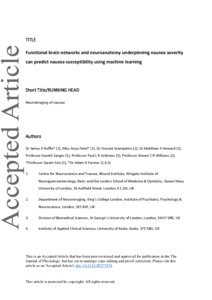Ruffle, JK; Patel, A; Giampietro, V; Howard, MA; Sanger, G; Andrews, PLR; Williams, SCR; Aziz, Q; Farmer, AD
(2019)
Functional brain networks and neuroanatomy underpinning nausea severity can predict nausea susceptibility using machine learning.
J Physiol, 597 (6).
pp. 1517-1529.
ISSN 1469-7793
https://doi.org/10.1113/JP277474
SGUL Authors: Andrews, Paul Lyn Rodney
![[img]](https://openaccess.sgul.ac.uk/110558/1.hassmallThumbnailVersion/Ruffle_et_al-2019-The_Journal_of_Physiology.pdf)  Preview |
|
PDF
Accepted Version
Available under License ["licenses_description_publisher" not defined].
Download (1MB)
| Preview
|
Abstract
KEY POINTS: Nausea is an adverse experience characterised by alterations in autonomic and cerebral function. Susceptibility to nausea is difficult to predict, but machine learning has yet to be applied to this field of study. The severity of nausea that individuals experience is related to the underlying morphology (shape) of the subcortex; namely of the amygdala, caudate and putamen. A functional brain network related to nausea severity was identified, which included the thalamus, cingulate cortices (anterior, mid and posterior), caudate nucleus and nucleus accumbens. Sympathetic nervous system function and sympathovagal balance was closely related to both this nausea-associated anatomical variation and functional connectivity network. Machine learning accurately predicted susceptibility or resistance to nausea. These novel anatomical and functional brain biomarkers for nausea severity may permit objective identification of individuals susceptible to nausea, using artificial intelligence/machine learning. Brain data may be useful to identify individuals more susceptible to nausea. ABSTRACT: Objectives Nausea is a highly individual and variable experience. The central processing of nausea remains poorly understood, although numerous influential factors have been proposed including brain structure, function and autonomic nervous system (ANS) activity. We investigated the role of these factors in nausea severity and if susceptibility to nausea could be predicted using machine learning. Design 28 healthy participants (15 male; mean age 24 years) underwent quantification of resting sympathetic and parasympathetic nervous system activity. All were exposed to a 10-minute motion-sickness video during fMRI. Neuroanatomical shape differences of the subcortex and functional brain networks associated with the severity of nausea were investigated. A machine learning neural network was trained to predict nausea susceptibility, or resistance, using baseline ANS data and detected brain features. Results Increasing nausea scores positively correlated with shape variation of the left amygdala, right caudate and bilateral putamen (corrected-p = 0.05). A functional brain network active in participants reporting nausea was identified implicating the thalamus, anterior, middle and posterior cingulate cortices, caudate nucleus and nucleus accumbens (corrected-p = 0.043). Both neuroanatomical differences and the functional nausea-brain network were closely related to sympathetic nervous system activity. Using these data, a machine learning model predicted susceptibility to nausea with an overall accuracy of 82.1%. Conclusions Nausea severity relates to underlying subcortical morphology and a functional brain network in its experience; both measures are potential biomarkers in trials of anti-nausea therapies. The use of machine learning should be further investigated as an objective means to develop models predicting nausea susceptibility.
| Item Type: |
Article
|
| Additional Information: |
This is the peer reviewed version of the following article: Ruffle, J. K., Patel, A. , Giampietro, V. , Howard, M. A., Sanger, G. J., Andrews, P. L., Williams, S. C., Aziz, Q. and Farmer, A. D. (2019), Functional brain networks and neuroanatomy underpinning nausea severity can predict nausea susceptibility using machine learning. J Physiol, 597: 1517-1529, which has been published in final form at https://doi.org/10.1113/JP277474. This article may be used for non-commercial purposes in accordance with Wiley Terms and Conditions for Use of Self-Archived Versions. |
| Keywords: |
06 Biological Sciences, 11 Medical And Health Sciences, Physiology |
| SGUL Research Institute / Research Centre: |
Academic Structure > Molecular and Clinical Sciences Research Institute (MCS) |
| Journal or Publication Title: |
J Physiol |
| ISSN: |
1469-7793 |
| Language: |
eng |
| Publisher License: |
Publisher's own licence |
| Projects: |
|
| PubMed ID: |
30629751 |
| Dates: |
| Date |
Event |
| 2019-03-15 |
Published |
| 2019-02-27 |
Published Online |
| 2018-12-21 |
Accepted |
|
 |
Go to PubMed abstract |
| URI: |
https://openaccess.sgul.ac.uk/id/eprint/110558 |
| Publisher's version: |
https://doi.org/10.1113/JP277474 |
Statistics
Item downloaded times since 21 Jan 2019.
Actions (login required)
 |
Edit Item |



